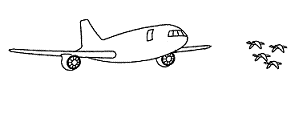Bird Strike Committee Proceedings
Date of this Version
August 2000
Abstract
Brazil built one of the world’s largest aeronautical infrastructures. The airport net is distributed along its vast territory, which shows a tremendous ecosystem variety. Having a large civilian aircraft fleet and also running second after Venezuela in catalogued bird species, Brazil has had problems related to bird strikes. Although Brazil has few problems with migratory birds, the threat posed by resident birds in some airports represents a significant risk. On the other hand, due to human population growth and poor policies of garbage disposal in the past, nowadays some big airports have in their vicinities open dumps that attract birds. That causes an ever-increasing population growth of a bird species similar to the Black Vulture, the Urubu (Coragyps atratus, wt 2Kg, 4lb), that survives by eating the carrion available in those places. Therefore, we have faced the rising risk of bird strikes around some airfields. The solution of the problem encompasses many institutions and requires a great variety of measures. The paper presents some successful actions that have been undertaken by the SIPAER, the Brazilian aviation safety system, to keep the avian hazard under control in Brazil.

